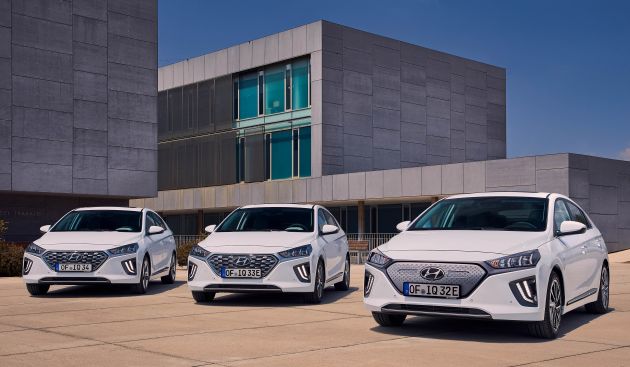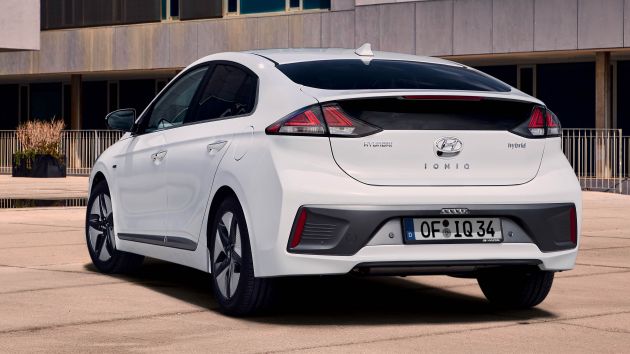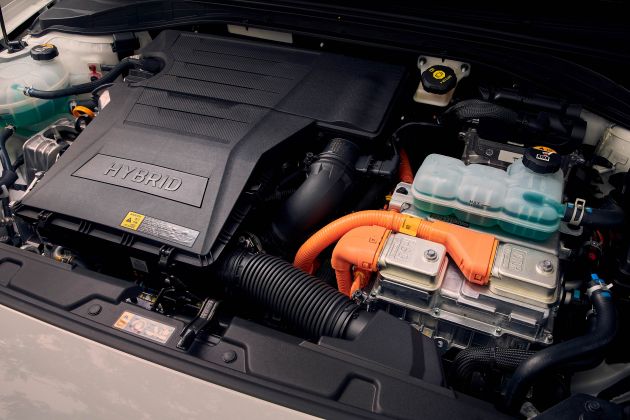Hyundai has released a lot more details about the facelifted Ioniq, which will continue to be offered with a hybrid (Hybrid), plug-in hybrid (Plug-in) and full electric (Electric) powertrain. The facelift brings with it some updates to the Ioniq’s styling, as well as powertrain and equipment enhancements.
Starting with what you can see, both the Hybrid and Plug-in models are now fitted with a new mesh-type radiator grille instead of a slated one. Meanwhile, the Electric model gets a distinctive pattern on its closed grille, which should liven things up when compared to the outgoing car’s rather “blank” space.
The new grilles aren’t the only significant changes here, as the LED headlamps and daytime running lights have been also redesigned to feature distinctive lighting patterns. Elsewhere, all models get a silver-coloured moulding at the bottom of the front bumper, while anthracite-coloured sections are present on the rear bumper moulding.
For the Plug-in and Electric, new 16-inch alloy wheels come as standard, while the Hybrid has the option of a 15- or 17-inch wheel design. Customers (in Europe) will get to choose from nine exterior colours, including four new ones: Fluidic Metal, Electric Shadow, Liquid Sand and Typhoon Silver.


Moving inside, there’s now a 10.25-inch AVN system that features Android Auto and Apple CarPlay support, as well as the ability to connect two phones via Bluetooth. There’s also Hyundai Blue Link, which offers a number of connected services via telematics, allowing customers to pre-condition their car (Electric model only), use satellite navigation, and perform certain remote functions.
That widescreen display is part of a more contemporary dashboard design, with highlights being slimmer air vents that blend into chrome trim, along with new switchgear for the climate control that uses touch-type buttons.
The Electric model continues to come with a seven-inch LCD display in the instrument binnacle, but it now comes with mood lighting to better visualise the different drive mode themes.
This feature is also available for hybrid and plug-in hybrid versions as an option. Other improvements inside the cabin include blue ambient lighting applied across the passenger-side lower dashboard and the centre console.
Still on the topic of available equipment, all Ioniq models come with the Hyundai SmartSense suite of safety and driver assist systems. Standard items are Front Collision Warning and Avoidance Assist with Pedestrian Detection with Cyclist Detection ability, Driver Attention Warning, Lane Keeping Assist and High Beam Assist.
More features such as Lane Following Assist, Intelligent Speed Limit Warning, Smart Cruise Control with Stop&Go, Leading Vehicle Departure Alert, Blind-Spot Collision Warning and Rear Cross-Traffic Collision Warning are available as options.
Powertrain-wise, both the Hybrid and Plug-in use a Kappa 1.6 litre four-cylinder Atkinson-cycle petrol that develops 105 PS at 5,700 rpm and 147 Nm of torque at 4,000 rpm, with a six-speed dual-clutch automatic transmission.
What’s different between the two are the electrified components used, with the Hybrid employing a 43.5 PS/170 Nm electric motor that draws power from a 1.56 kWh lithium-ion battery (42 kW, 240 V).


The Plug-in uses a slightly more powerful 60.5 PS/170 Nm electric motor instead, and has a higher-capacity 8.9 kWh Li-ion battery (59 kW, 360 V). The plug-in hybrid model also gets a 3.3 kW onboard charger.
Despite the different outputs of the electric motors, the system output for both the Hybrid and Plug-in is exactly the same at 141 PS and 265 Nm. Hyundai says the Hybrid can run on pure electricity at speeds of up to 120 km/h, while the Plug-in is capable of delivering 52 km of range (WLTP target figure) on electricity alone.
The specifications of the Hybrid and Plug-in’s powertrains are pretty much the same as before, but not so with the Electric. The electric motor here is now slightly more powerful at 136 PS and 295 Nm, allowing for a top speed of 165 km/h.
More importantly, the battery capacity has been increased from 28 kWh to 38.3 kWh (113 kW, 319.4 V), allowing for range of up to 294 km (WLTP target figure). There’s also a new onboard charger rated at 7.2 kW, which is an upgrade from the previous 6.6 kW unit for AC charging via a Type 2 connector.
There’s also support for DC charging with a CCS connection, so it would take about 57 minutes to charge from zero to 80% with a 50 kW charge point, or 54 minutes with a 100 kW station instead.
To help improve efficiency, Eco-Driving Assist System (Eco DAS) is standard on the Plug-in and Hybrid, which uses road information from the navigation system to inform the driver when deceleration is imminent. It will also manage charging and discharging of the battery in uphill and downhill situations to maximise battery usage.
There’s also Adjustable Regenerative Braking in Eco mode, so drivers can select from a selection of intensity levels for the regenerative braking system via the paddle shifters. In Sport mode, the paddles act as manual shifters for the dual-clutch transmission.
As for the Electric, it takes a page from the Kona Electric by adopting one-pedal driving capability, so drivers can stop the car by simply holding onto the left paddle shift lever with no need to engage the brake pedal.
Additionally, there’s now Eco+, which supplements the standard Eco, Comfort and Sport driving modes to help drivers reduce their energy consumption so the remaining energy can be extended during unforeseeable emergency situations.
Source: Read Full Article





